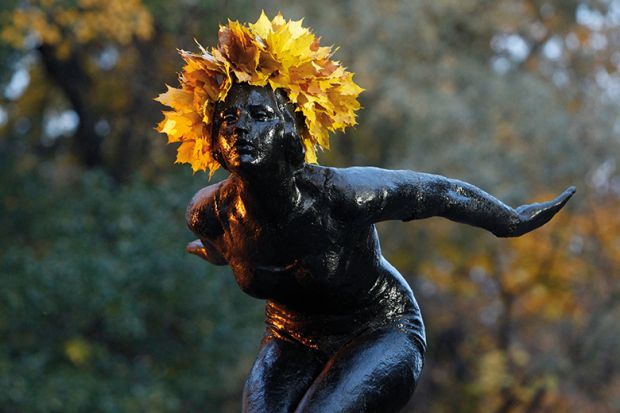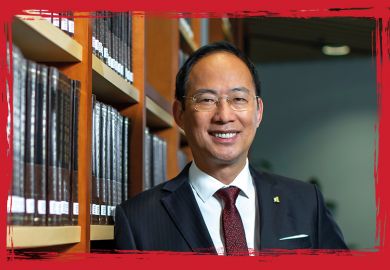Browse the top 200 Golden Age universities
The Ruhr region in Germany is the largest urban area in the country and the third largest in the European Union, with a population of more than 5 million people, but the coal mining and steel district had no universities until the 1960s.
So when Ruhr University Bochum was established in 1962 and opened three years later, it was “a big change”, says its rector Axel Schölmerich. As the first university to be founded in Germany after the Second World War, it was a significant change for the country, too.
Today, RUB is still unique for its comprehensive mission. Engineering schools are typically limited to Germany’s universities of applied sciences, but from its foundation RUB has been an institution that has covered “all the fields”, from humanities to medicine to engineering, says Schölmerich.
One of the advantages of having departments in such a wide range of disciplines is that RUB is able to conduct highly interdisciplinary research. Schölmerich says that the university has established “research departments” based on specific current questions rather than disciplines to help facilitate such collaboration.
“If you have all the fields of science on one campus, you can easily combine those people. I think that’s part of the success story of our university [and why we] have this relatively short history but reach a very good position in the international rankings,” he says.
RUB ranks 33rd in Times Higher Education’s 2018 “Golden Age” ranking of the best universities that were founded in the aftermath of the Second World War (between 1945 and 1967), up from 42nd in the debut edition of the table last year.
It improved on three main areas: citation impact, industry income and research.
Schölmerich says that its focus on increasing collaboration with international scholars helps to boost the visibility of its research and therefore ups its citation impact.
Meanwhile, its interdisciplinary approach attracts income from industry, sometimes in unusual areas. While the university’s engineering department receives the highest share of third-party funding, the “humanities have a surprisingly large proportion of this income” as a result of the individual and combined excellence of scholars in the arts and sciences, says Schölmerich.
As middle-aged institutions, universities in the Golden Age ranking – so named to reflect what THE describes as the Golden Age in global higher education, characterised by rapid university expansion and increasing investment in research – are distinguished by having the benefit of both youth and age. They typically have had time to build up the quality of their research and their reputation but also tend to be more agile and innovative than many of their older counterparts.
This year’s ranking showcases a much greater range of Golden Age stars – it has been expanded to include 200 universities, up from 100 last year.
The table also includes nine new universities that were founded in 1967; these institutions previously featured in our “under 50” table (see page 31) but graduated to join the Golden Age list after reaching their 51st birthday.
So the ranking this year provides a quite different overall picture.
For instance, the UK was the most-represented country in last year’s table, with 19 universities. While it has four more institutions this year, the crown now goes to Japan, which has 28 universities, almost all of which were founded in 1949. Just one Japanese university – Hiroshima University – featured last year.
Other Asian universities whose scores were too low to make last year’s ranking have also reared their heads this year, thanks to the expansion. India now has 11 universities, up from seven, and China has 17, up from five.
The top 10 is relatively stable however, featuring the same list of institutions, albeit in a different order. The University of California, San Diego and Australian National University hold on to the top two places.
Futao Huang, professor at the Research Institute for Higher Education at Hiroshima University, says that Japan’s higher education expansion after the Second World War is a result of the 1947 Education Act, which called for the “establishment of national and local public universities in each prefecture” of the country and the “expansion of higher education with a purpose of accepting more students from a wide range of backgrounds and social classes”.
Meanwhile, during the US Occupation period of 1945 to 1951, Japan’s “pre-war higher education system, with complicated levels and types of various institutions, was transformed into a single four-year university system, strongly influenced by the US model”, he says.
As a result, almost all the existing national universities were rebuilt and newly founded from 1948 to the mid 1950s, and others developed or merged from pre-war colleges, he adds.
Hiroshima University, which leads Japan’s cohort at 97th place, is one such example. It was established in 1949, “out of the burned ground of a bombed city” after a merger of nine institutions, says its president Mitsuo Ochi.

The UK is the next most-represented nation in the table, with 23 universities, led by the University of Warwick in eighth place. The country’s success is due to the birth of “plate-glass” universities after the 1963 Robbins report.
Newcastle University, which climbs four places to 20th this year, was formerly a School of Medicine and Surgery and then a college at Durham University, and became a stand-alone university in 1963.
The university’s research environment, industry income and international outlook scores have all improved this year.
Richard Davies, pro-vice-chancellor for engagement and internationalisation, says that the institution now has more international students, publications and staff on campus, the last of which could be a result of several international PhD students rising through the ranks to become full members of staff.
“We like to think that Newcastle – the university and the city – are very welcoming places…They’re good places to live so people want to stay once they’ve done their PhD,” he explains.
The university has also made two changes to its process of working with industry, which may explain why it receives a higher share of income from firms per member of academic staff this year.
The university’s top 50 industry partners now have a “facilitator” in the institution – a professional service staff member who can manage the relationship. There is now also a single contact point for all enquiries from business from which requests can be filtered out to relevant staff.
“We’ve provided a certain level of structure, which means that we can be more strategic in those partnerships [and] make sure they’re being looked after,” says Davies.
Another institution that is no stranger to working with industry is Eindhoven University of Technology, which has risen eight places to 15th place this year. It was the second engineering university to be established in the Netherlands.
Rector magnificus Frank Baaijens says that the university was founded in 1956 at a time when “Philips Electronics in particular was growing very rapidly and they were in very high need of well-educated engineers”.
But while the university has always had a strong relationship with industry, it has improved on the industry income measure this year.
Baaijens’ explanation is that “the companies in the region are growing very rapidly and spending a large amount of research and development funding”.
“If you look at private R&D [outlay], spending in this region is by far the highest in the Netherlands and it exceeds E2 billion (£1.75 billion) on an annual basis,” he says.
Baaijens attributes some of its success to the fact that it is a “very modern university” and a “medium-sized” institution – a feature of many universities in the table. The institution has 12,500 students but hopes to grow this to 15,000.
“The larger you are, the more difficult it is to adjust to a new situation,” he says.
“We are a single campus university, which is well connected internally and also well connected with the ecosystem that we have, so we can adjust relatively quickly.”
RUB’s Schölmerich also believes that a university’s age and character are inextricably linked.
Unlike Heidelberg and Tübingen, Bochum is “not a traditional” university town with a long history of relating to science, and this means that RUB can come across as more “accessible”, he says. “If you work with small and medium firms that are spread out over the area, it is actually helpful not to have this image of: ‘this is an old type of university, where there is such a distance between [industry and] these scientific-minded people’. We’re approachable.”
This friendly demeanour is also helpful when it comes to attracting local prospective students – many of whom come from families who have not experienced higher education.
“We don’t have a history of Nobel prizewinners – that’s something that we still need to work on,” he says. “But for people in the metropolitan area, this is the place to send your kids to, and I think that’s one defining feature of Ruhr University.”
POSTSCRIPT:
Print headline: Autumnal colours
Register to continue
Why register?
- Registration is free and only takes a moment
- Once registered, you can read 3 articles a month
- Sign up for our newsletter
Subscribe
Or subscribe for unlimited access to:
- Unlimited access to news, views, insights & reviews
- Digital editions
- Digital access to THE’s university and college rankings analysis
Already registered or a current subscriber? Login










